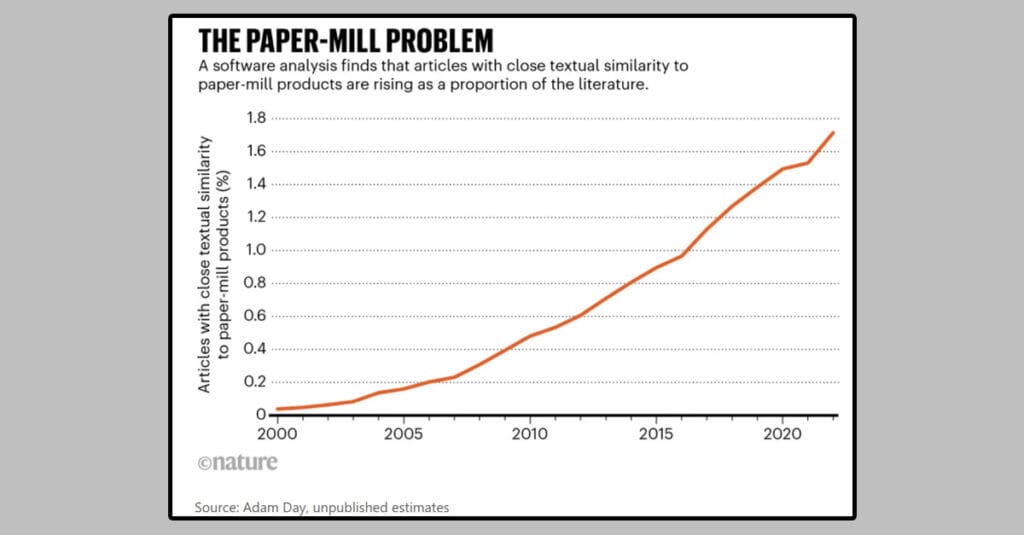What Are Paper Mills?
Paper mills produce low-quality or fraudulent research papers in bulk for profit. These organizations are common in scientific publishing, creating and selling articles that are either heavily manipulated or entirely fabricated. Their primary customers are researchers or students who need publications to meet academic or professional requirements. While scientific publishing aims to share genuine findings that contribute to knowledge, paper mills compromise this by flooding the scientific archive with misleading or false information.
Purpose and Motives
Paper mills exploit the “
publish or perish” culture, where researchers face immense pressure to publish regularly to advance their careers. In many academic and professional environments, publications are crucial for promotions, funding, and job security. Paper mills provide an attractive shortcut for individuals who may struggle with research quality, time constraints, or the technical skills needed to conduct rigorous research. By purchasing papers, these individuals can bypass traditional research processes, which often take months or years.
The production of paper mill articles involves minimal or no actual research. Instead, paper mills focus on creating content that looks credible enough to pass through journal editorial processes. Their primary motive is financial gain. Clients pay for these fabricated papers to achieve personal or professional milestones, making paper mills a profitable but unethical business model.
How Paper Mills Operate
- Assembly Line Production: Paper mills often work like assembly lines. They have teams of writers who generate papers on demand, usually following templates to speed up production. These templates outline common study structures, phrasing, and even citation patterns, ensuring that articles look “scientific” without containing any real insights or data.
- Data Fabrication and Manipulation: In some cases, paper mills use completely fabricated data, while in others, they recycle data from existing studies, modifying details to avoid detection. They may also manipulate statistical results or graphics to make the findings appear significant.
- Plagiarism and Self-Plagiarism: Many paper mill articles rely on plagiarism or self-plagiarism. Writers might copy sections from previously published works or from papers produced for other clients, making minor adjustments to avoid detection by plagiarism-checking software. This approach allows paper mills to produce a large volume of content quickly.
- Journal Targeting: Paper mills often target low-quality or predatory journals, which have less rigorous peer review processes. Some predatory journals accept submissions for a fee, publishing papers without meaningful quality checks. This lack of scrutiny enables paper mills to get their papers published, creating a veneer of legitimacy for clients.
Impact on Scientific Publishing
Paper mills present a significant problem for scientific publishing. By inserting low-quality or false papers into the scientific archive, they damage the credibility of journals and mislead researchers. When researchers cite these papers or base their own work on paper mill content, they risk spreading misinformation or building on false premises.
The presence of paper mills makes it difficult for readers, and other researchers, to distinguish between genuine and fabricated studies. This confusion can affect real research, leading to wasted time, resources, and potential setbacks.
For journals, publishing paper mill content damages their reputation and erodes trust among the academic community. Journals may face scrutiny from other researchers, institutions, and funding bodies, especially if they regularly accept low-quality submissions. In response, some journals have implemented stricter review processes to filter out suspicious papers.
One of the most recent cases of paper mills affecting publishers is the recent sunsetting of Hindawi, which was bought by Wiley, was overrun by paper mills papers and the publisher has had to retract at least 8,000 papers.
Recognizing Paper Mill Content
Detecting paper mill content is challenging, but there are some common signs:
- Repetitive Structure and Language: Paper mill articles often follow rigid templates, making them appear formulaic. The language may lack variation, with similar phrases repeated across multiple papers.
- Weak Data and Analysis: Fabricated studies may feature shallow or poorly explained data and analysis. Statistics might lack context or be presented without adequate explanation.
- Inconsistent Authorship Information: Authors on paper mill articles sometimes use fake names or list authors without clear affiliations. In some cases, the same names may appear across unrelated papers, indicating possible involvement in paper mill activity.
- Unconvincing Results: Results in paper mill studies may seem unusually significant or perfect. Data might appear too consistent, lacking the natural variation typical in genuine research.
Measures to Combat Paper Mills
- Stricter Peer Review: Journals can adopt more rigorous peer review processes to catch potential paper mill submissions. Some use software to detect common paper mill phrases, inconsistent authorship information, or suspicious data patterns.
- Researcher and Journal Awareness: Increasing awareness about paper mills among researchers, editors, and reviewers is essential. Many institutions now offer training on ethical publishing, helping authors recognize the importance of genuine research contributions.
- Improved Technology: Advances in artificial intelligence (AI) can help detect fabricated content and suspicious data. Some journals have started using AI tools that analyze language patterns, citation structures, and data authenticity.
- Institutional Policies: Universities and research institutions are now establishing policies to discourage the use of paper mills. Many institutions investigate questionable publications and may impose sanctions on researchers who use such services.
Conclusion
Paper mills pose a serious threat to the integrity of the scientific archive. By generating and selling fraudulent research, they compromise the quality of academic literature and mislead the scientific community. Combatting paper mills requires collective efforts from journals, institutions, and researchers to promote ethical publishing and maintain trust in scientific research.
Disclosure
An initial version of this article was generated with ChatGPT using the prompt ‘
Please write about 600 words for an article titled “What are paper mills”. This should be in the context of scientific publishing, rather than mills that produce paper.‘
The text that was returned was edited by the author. The author takes full responsibility of this content.


